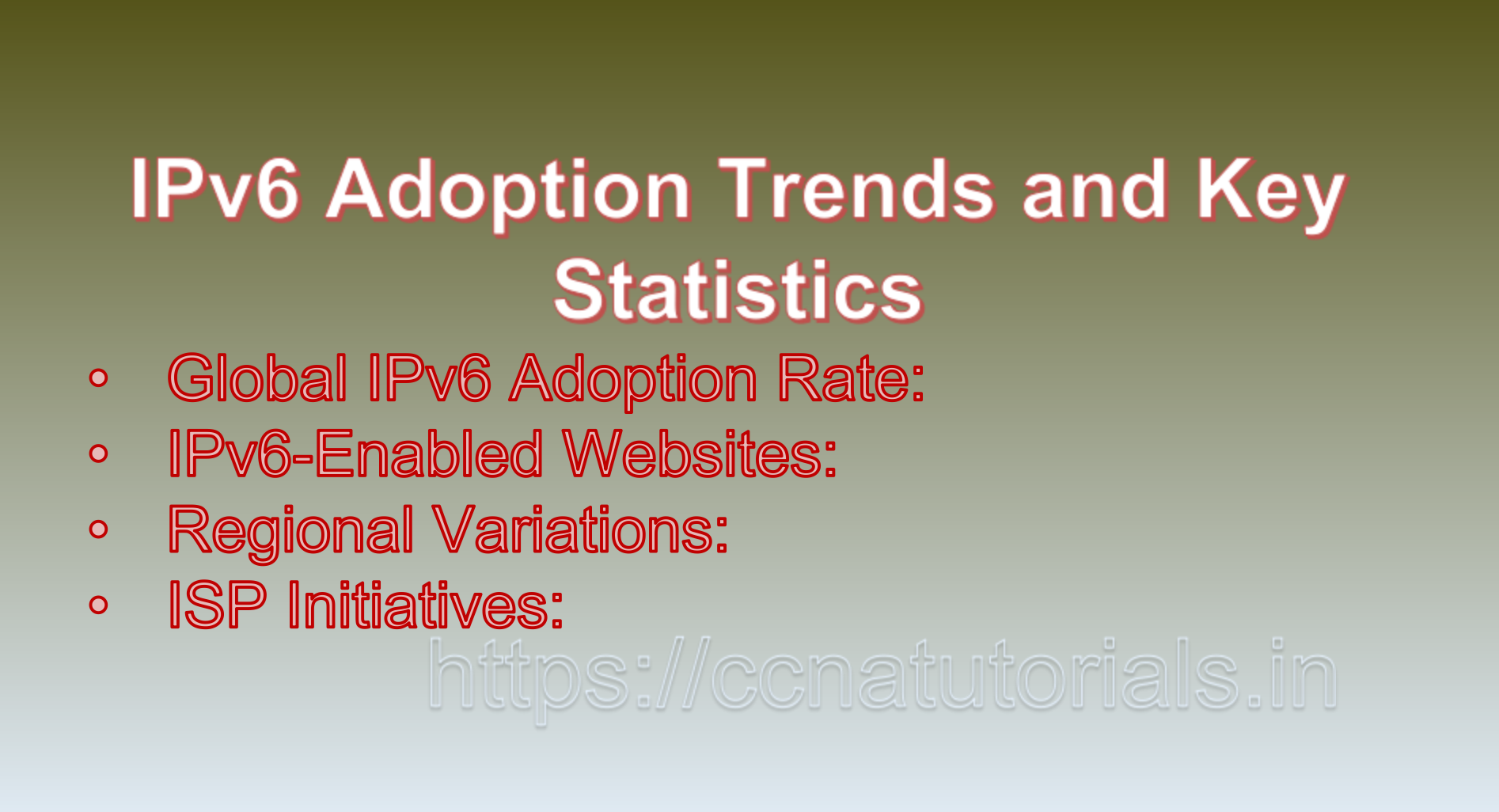Contents of this article
In this article, I describe IPv6 Adoption and Statistics: Tracking the Transition to the Future of Internet Connectivity. As the world grapples with the depletion of IPv4 addresses, the transition to IPv6 (Internet Protocol version 6) becomes increasingly vital. IPv6 offers an expansive address space and improved features to accommodate the growing number of connected devices. Monitoring IPv6 adoption and understanding relevant statistics provide insights into the progress and challenges of this transition. In this article, we will explore IPv6 adoption trends, key statistics, and examples of how different regions and sectors are embracing IPv6 to pave the way for a more connected and sustainable digital future.
IPv6 Adoption Trends and Key Statistics
1. Global IPv6 Adoption Rate:
The global adoption rate of IPv6 is steadily increasing. Internet Service Providers (ISPs), content providers, and organizations are working to enable IPv6 connectivity to address the limitations of IPv4 and support the proliferation of devices.
2. IPv6-Enabled Websites:
Major websites and content providers have adopted IPv6, allowing users to access their services over IPv6. Google, Facebook, and YouTube are among the top websites accessible via IPv6.
3. Regional Variations:
IPv6 adoption rates vary by region. Some countries and regions, particularly in North America and Europe, have higher adoption rates due to proactive efforts by ISPs and industry leaders.
4. ISP Initiatives:
ISPs play a critical role in driving IPv6 adoption. Many ISPs worldwide have implemented IPv6 connectivity for their customers, enabling them to access the internet using IPv6 addresses.
5. Mobile Networks:
Mobile networks are embracing IPv6 to address the surge in connected mobile devices. IPv6 support in mobile networks ensures that smartphones and other devices have unique IP addresses.
6. Internet of Things (IoT):
With the growth of IoT devices, IPv6 is becoming essential for providing unique addresses to an ever-expanding array of interconnected devices.
Examples of IPv6 Adoption Initiatives
1. North America:
The American Registry for Internet Numbers (ARIN) actively promotes IPv6 adoption. Many ISPs in the United States and Canada offer IPv6 connectivity to their customers. Major content providers such as Google, Facebook, and Netflix have IPv6-enabled websites, contributing to the growth of IPv6 traffic.
Example: Comcast, one of the largest ISPs in the US, has deployed IPv6 to a significant portion of its subscriber base, ensuring that its customers can access IPv6-enabled websites and services.
2. Europe:
European countries have been proactive in IPv6 adoption, with several governments and ISPs driving initiatives to promote IPv6 connectivity. The European Union’s IPv6 Task Force works to raise awareness and facilitate the transition.
Example: Switzerland’s SWITCH Foundation, responsible for the .ch top-level domain, has been actively promoting IPv6 adoption. The organization provides resources, training, and support to encourage Swiss websites to adopt IPv6.
3. Asia-Pacific:
Some countries in the Asia-Pacific region have made substantial progress in IPv6 adoption. Governments and ISPs in Japan, South Korea, and China have taken steps to enable IPv6 connectivity for their citizens.
Example: Japan’s National Institute of Information and Communications Technology (NICT) runs an IPv6 promotion council that works to accelerate IPv6 deployment in the country. The council collaborates with ISPs, businesses, and government agencies to drive adoption.
Challenges in IPv6 Adoption
1. Lack of Awareness:
Many organizations and individuals are not fully aware of the importance of IPv6 or the potential implications of not adopting it.
2. Legacy Infrastructure:
Transitioning from IPv4 to IPv6 can be complex, especially for organizations with legacy systems that are not easily compatible with the new protocol.
3. Budget Constraints:
Implementing IPv6 may require investments in training, equipment, and network upgrades, which can be challenging for organizations with limited resources.
4. Vendor Support:
Ensuring that network equipment, software, and applications support IPv6 can be a hurdle, particularly if vendors are slow to provide updates.
5. Address Management:
Effectively managing IPv6 addresses, allocations, and subnets requires careful planning and coordination.
Short description of IPv6 Adoption and Statistics
IPv6 adoption is a critical step towards addressing the limitations of IPv4 and ensuring the continued growth of the internet. While adoption rates vary by region and sector, efforts to promote and enable IPv6 connectivity are gaining momentum globally. The transition to IPv6 offers enhanced connectivity, improved security, and support for the proliferation of devices in an increasingly digital world. By monitoring IPv6 adoption trends and statistics and learning from successful initiatives, governments, ISPs, organizations, and individuals can collectively pave the way for a future with a more connected and sustainable internet infrastructure.

IPv6 Adoption and Statistics: Tracking the Transition to the Next-Generation Internet Protocol
The transition from IPv4 to IPv6 (Internet Protocol version 6) is a pivotal development in the evolution of the internet. As the world exhausts the available IPv4 addresses, the adoption of IPv6 becomes increasingly essential to accommodate the growing number of connected devices. In this article, we will explore the current state of IPv6 adoption, highlight key adoption statistics, discuss factors influencing adoption, and provide examples to illustrate the significance of IPv6 in modern networking.
The State of IPv6 Adoption
IPv6 adoption has gained momentum over the years, as organizations and service providers recognize the limitations of IPv4 and the advantages that IPv6 offers. While IPv4 addresses are running out, IPv6 provides an expansive address space, improved routing efficiency, and support for new technologies like IoT. Despite the benefits, the transition to IPv6 is a complex process that requires planning, implementation, and monitoring.
Key IPv6 Adoption Statistics
1. IPv6 Address Allocation:
Regional Internet Registries (RIRs) responsible for allocating IP addresses have reported a significant increase in IPv6 address assignments. For example, the American Registry for Internet Numbers (ARIN) and the Asia-Pacific Network Information Centre (APNIC) have allocated large blocks of IPv6 addresses.
2. Global IPv6 Traffic Percentage:
According to data from Google’s IPv6 Adoption Statistics, as of September 2021, over 35% of users access Google services over IPv6. This indicates a growing number of networks and devices that are IPv6-enabled.
3. Top IPv6-Connected Countries:
Some countries have embraced IPv6 more aggressively than others. Belgium, for instance, has consistently shown high levels of IPv6 adoption, with a large percentage of internet traffic being IPv6.
4. Mobile Network Operators (MNOs):
Mobile operators are crucial in driving IPv6 adoption due to the proliferation of mobile devices. Many MNOs are deploying IPv6 in their networks to support the growing number of smartphones and other connected devices.
5. Content Providers:
Major content providers, such as Google, Facebook, and YouTube, have enabled IPv6 access to their services. This encourages ISPs and networks to enable IPv6 to ensure smooth connectivity to these platforms.
Factors Influencing IPv6 Adoption
1. Address Exhaustion:
The depletion of available IPv4 addresses has been a driving factor for IPv6 adoption. As businesses and service providers expand their networks, they face the need for more IP addresses, which IPv6 can provide.
2. Internet of Things (IoT):
The explosion of IoT devices, from smart home appliances to industrial sensors, requires an address space that IPv6 can accommodate.
3. Future-Proofing:
Organizations recognize that IPv6 is necessary for the long-term sustainability of their networks. Investing in IPv6 adoption now ensures that they are prepared for the future growth of the internet.
4. Internet Service Providers (ISPs):
ISPs play a critical role in IPv6 adoption by enabling IPv6 connectivity for their customers. As more ISPs enable IPv6, users are more likely to experience IPv6 traffic.
5. Content Accessibility:
The availability of IPv6-enabled content drives the adoption of IPv6. Content providers that make their services accessible over IPv6 encourage networks to adopt the protocol.
Examples Illustrating IPv6 Adoption
1. Mobile Network Operator (MNO):
A mobile operator realizes the importance of IPv6 adoption due to the increasing number of smartphones and tablets. To ensure that its customers have a seamless experience, the operator deploys IPv6 in its network, enabling all devices to communicate over IPv6. This move not only future-proofs the network but also improves connectivity for IPv6-enabled applications.
2. IoT Deployment:
An industrial facility deploys IoT sensors to monitor equipment health and optimize operations. With the growing number of sensors, the facility adopts IPv6 to ensure that each sensor can be assigned a unique IPv6 address. This allows for efficient communication between sensors and central management systems without the need for complex address management.
3. Content Provider Strategy:
A popular social media platform ensures that its services are accessible over IPv6. As a result, ISPs and networks prioritize IPv6 adoption to ensure smooth access to the platform. This collaboration between content providers and networks accelerates the overall adoption of IPv6.
Conclusion for IPv6 Adoption and Statistics
IPv6 adoption is an essential transition that addresses the limitations of IPv4 and supports the growing demands of a connected world. The adoption of IPv6 addresses the depletion of available IPv4 addresses, accommodates the proliferation of IoT devices, and future-proofs networks for sustained growth. Key factors influencing adoption include the exhaustion of IPv4 addresses, the rise of IoT, and the collaboration between ISPs and content providers. As IPv6 adoption continues to gain momentum, networks and organizations that embrace the protocol will be well-positioned to thrive in the evolving landscape of modern networking.
I hope you found this article helpful, you may drop a comment below or contact us for any query related to this article.






